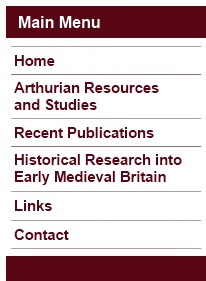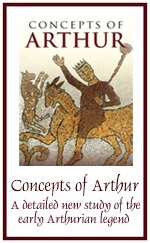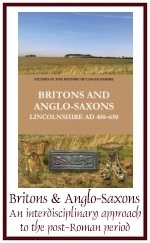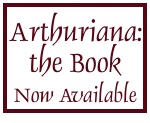
 |
 |
Concepts
of Arthur: Author's Notes & Comments
Two
categories of notes and comments on Concepts
of Arthur (Stroud, 2007) can be found below.
First, brief notes on recent academic publications
which are relevant to the arguments made in Concepts
but which appeared too late for use of them to be made
therein.
Second, notes on the published text of Concepts of
Arthur, which will appear as the need for them
comes to my attention. Despite the lengthy process of editing and
proof-reading, minor errors can be introduced or overlooked and these
will be corrected as they are found. The title-less 'Book of Taliesin' poem XIV -- sometimes known as Golychafi Gulwyd from its first line -- is used in several places in Concepts of Arthur (pp. 55-56, 63, 158, 165), with a ninth or tenth century composition suggested (see Jones and Jones, 1949: xiii and Sims-Williams, 1982: 243). John Carey has recently supported dating this poem to the tenth century or before, suggesting further that it may be of a similar date to Preideu Annwfyn: 'The two poems are written in the same metre, and share some of the same diction... There appear to be no linguistic indications that they differ in date. It is indeed conceivable that they are the work of a single poet...' (Carey, 2007: 86, 130). References: J. Carey, Ireland and the Grail (Aberystwyth: Celtic Studies Publications, 2007); T. Jones and G. Jones, The Mabinogion (London: Dent, 1949); P. Sims-Williams, 'The evidence for vernacular Irish literary influence on early medieval Welsh literature' in D. Whitlock et al (edd.) Ireland in Early Medieval Europe: Studies in Memory of Kathleen Hughes (Cambridge: 1982), pp. 235-57 Kat Godeu and gwrith Marged Haycock has taken gwrith in the 'Book of Taliesin' poem Kat Godeu as the impersonal preterite formed from the to- participle, gwrith (< *wrichto-), and notes its rare and potentially archaic nature (Haycock, 2007: 24-25, 188). She thus treats it in much the same way as Koch has, with Koch arguing that Kat Godeu's gwrith < *wrichto- reflects an older (i.e. Archaic Welsh) form of the Old Welsh and later gwnaethpwyt, 'was made', an argument which is utilised in Concepts of Arthur, p. 66 (Koch, 1991: 116 and Koch, 1997: 90-3, 208, 209). It ought further to be noted that Haycock proposes an emendation to line 146 of Kat Godeu (2007: 221-22) which would both help elucidate the line and bring the number of possible instances of gwrith < *wrichto- in the poem to five. References: J.T. Koch, 'Gleanings from the Gododdin and other Early Welsh texts', Bulletin of the Board of Celtic Studies, 38 (1991), pp. 111-18; J.T. Koch, The Gododdin of Aneirin: Text and Context from Dark-Age Britain (Cardiff: University of Wales Press, 1997); M. Haycock, Legendary Poems from the Book of Taliesin (Aberystwyth: CMCS, 2007) Kadeir Teyrnon, Arthur and Aladur In Concepts of Arthur, p. 197 (and in more detail in Green, 2007) it was argued that Arthur is the subject of the first part of the Book of Taliesin poem Kadeir Teyrnon. It was also suggested that the description of this subject as o echen aladur should be read as a indicating that he (Arthur) was 'from the stock/lineage/family/tribe of [the Romano-British war-god Mars] Alator'. Finally, it was argued that this description of/ancestry for Arthur might be merely laudatory, but it could well not be. Haycock has recently supported both the identification of the subject of the poem as Arthur and the identification of aladur as Mars Alator, in her edition of the 'Book of Taliesin' (2007: 293, 300). Furthermore she notes (2007: 300) that Uthyr Pendragon's uncle -- and thus Arthur's great-uncle -- in Geoffrey of Monmouth's Historia Regum Britanniae, vi.4, Aldroenus, is given the name Aldwr in the brutiau, which could well be relevant and might help confirm that the description of Arthur as 'from the family of (Mars) Alator' was meant literally. References: Green, 'A Note on Aladur, Alator and Arthur', Studia
Celtica, 41 (2007), pp. 237-41; M. Haycock, Legendary
Poems from the Book of Taliesin (Aberystwyth: CMCS, 2007) Linnuis, Lincoln and the kingdom of *Lindes In Concepts of Arthur, pp. 210-15, it was argued that some of the Historia Brittonum's Arthurian battles were placed within a genuine fifth- to sixth-century British kingdom (*Lindes) based at Lincoln, which seems to have been able to control Anglo-Saxon settlement in its region into at least the early sixth century. Green (2008) now provides a full and detailed discussion of both the evidence for this kingdom and the significance of its appearance as a battle-site in the Historia Brittonum. References: Green, 'The British Kingdom of Lindsey', Cambrian Medieval Celtic Studies, 56 (2008), pp. 1-43 The date of Kat Godeu Marged Haycock (2007, especially pp. 21-36) has recently argued that there is a degree of correspondence between the language and diction of the poet Prydydd y Moch (fl. c.1174/5-c.1220) and that of Kat Godeu and some of the other legendary poems from the 'Book of Taliesin'. If this correspondence can be sustained then there would seem to be three explanations which might be adopted: (1) that Prydydd y Moch was the author of Kat Godeu and at least some of the other Taliesin poems and that these poems are therefore no older than the late twelfth century; (2) that Kat Godeu and the other poems were composed before the late twelfth century, as is usually agreed, but that Prydydd y Moch had a hand in modernising them at some point before they found their way into the 'Book of Taliesin' (almost all poems older than the twelfth century show some evidence of modernisation, if only in terms of orthography); or (3) that Prydydd y Moch was familar with the texts of Kat Godeu and the other legendary Taliesin poems and was heavily influenced by them, with the result that he adopted stylistic elements from them in his own work. Although Haycock has made a tentative case in favour of the first of these possibilities, the third explanation (or perhaps some combination of the third and second explanations) seems more credible, at least with regards to Kat Godeu and perhaps generally too. Certainly such a scenario would help account for those archaic features internal to Kat Godeu which suggest the existence of a pre-twelfth-century -- and potentially pre-ninth-century -- written exemplar ultimately underlying the 'Book of Taliesin' text of Kat Godeu (Koch, 1991: 112-13, 116; Concepts of Arthur, pp. 65-66). Indeed, not only does Haycock herself note the apparent presence of gwrith < *wrichto- in the poem (see above) but she also identifies a number of words in Kat Godeu whose spelling points to the existence of an earlier version written in Old Welsh orthography (Haycock, 2007: 200, 210, 217). References: J.T. Koch, 'Gleanings from the Gododdin and other Early Welsh texts', Bulletin of the Board of Celtic Studies, 38 (1991), pp. 111-18; J.T. Koch, 'The Celtic Lands', in N.J. Lacy (ed.) Medieval Arthurian Literature: A Guide to Recent Research (New York: Garland, 1996), pp. 239-322; M. Haycock, Legendary Poems from the Book of Taliesin (Aberystwyth: CMCS, 2007) The nature of Kat Godeu In Concepts of Arthur, pp. 62-67, the poem Kat Godeu was treated as reflecting a genuine Welsh tale of a mythical battle involving an animated tree-army and the divine sons of Don. An alternate interpretation suggested in recent years is that the poet did not intend the 'Battle of the Trees' to be taken seriously but rather invented it as an ironic pastiche of the norms of heroic poetry (Haycock, 1990). However, not only would the other references to the 'Battle of the Trees' -- such as those in Golychafi Gulwyd and Trioedd Ynys Prydein -- seem to suggest that this battle was indeed considered a genuine part of Welsh tradition, but Francesco Benozzo (2004, pp. 109-21) has recently made a powerful argument against the interpretation of Kat Godeu as a mock-heroic parody. In the same vein, Mary-Ann Constantine has warned that 'there is something very late-twentieth-century about an ironic pastiche' (2003, p. 46). References: M. Haycock, 'The Significance of the "Cad Goddau" Tree-List in the Book of Taliesin', in M.J. Bell et al (edd.), Celtic Linguistics: Readings in the Brythonic Languages for T. Arwyn Watkins (Amsterdam: John Benjamins, 1990), pp. 297-331; M.-A. Constantine, 'The Battle for the "Battle of the Trees"', in I. Firla and G. Lindop (edd.), Graves and the Goddess: Essays on Robert Graves' The White Goddess (Selinsgrove: Susquehanna University Press, 2003), pp. 40-51; F. Benozzo, Landscape Perception in Early Celtic Literature (Aberystwyth: Celtic Studies Publications, 2004). Kaer Rigor and Preideu Annwfyn The third awdl of Preideu Annwfyn was only treated very briefly in Concepts of Arthur. It was suggested there that this awdl might potentially reference some tale of Arthurian exploits in a frozen hell, given that Preideu Annwfyn seems to allude to a number of independent Arthurian raids on the Otherworld and kaer rigor -- the fort under attack in the third awdl -- can be translated as 'the Frigid Fort' (Concepts of Arthur, p. 59). This idea has now been fully developed in Green (2009), which looks at the translation and interpretation of the awdl as a whole; this article also offers some further discussion of the idea that multiple Arthurian tales -- including the 'Battle of the Trees' -- are alluded to in Preideu Annwfyn. References: Green, 'An Alternative Interpretation of Preideu Annwfyn, lines 23-8', Studia Celtica, 43 (2009), pp. 207-13. . p.19, line 33 etc: 'Guinnon' should read 'Guinnion' here and elsewhere. [Noted 25 January 2008] Copyright © 2008, 2014 Caitlin R. Green. All Rights Reserved. To cite articles or pages from this website, use a service such as WebCite or alternatively see one of the following style citation guides. Comments and queries via email to Caitlin R. Green. |
   |